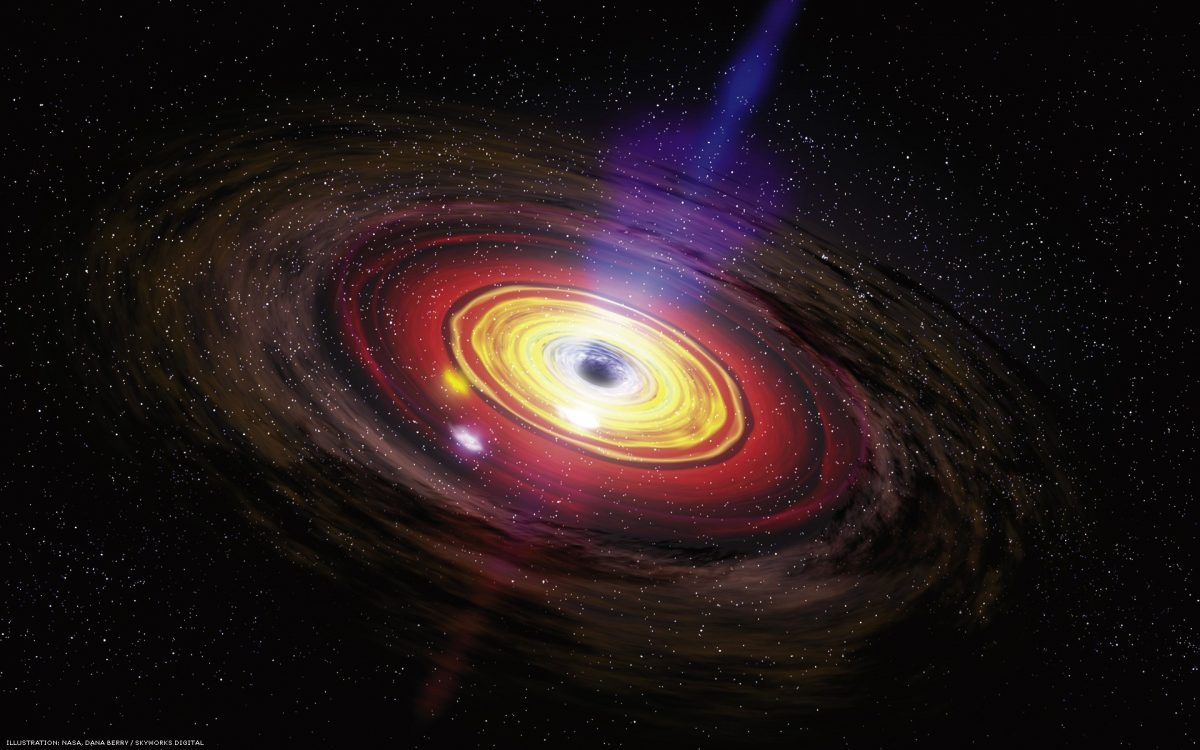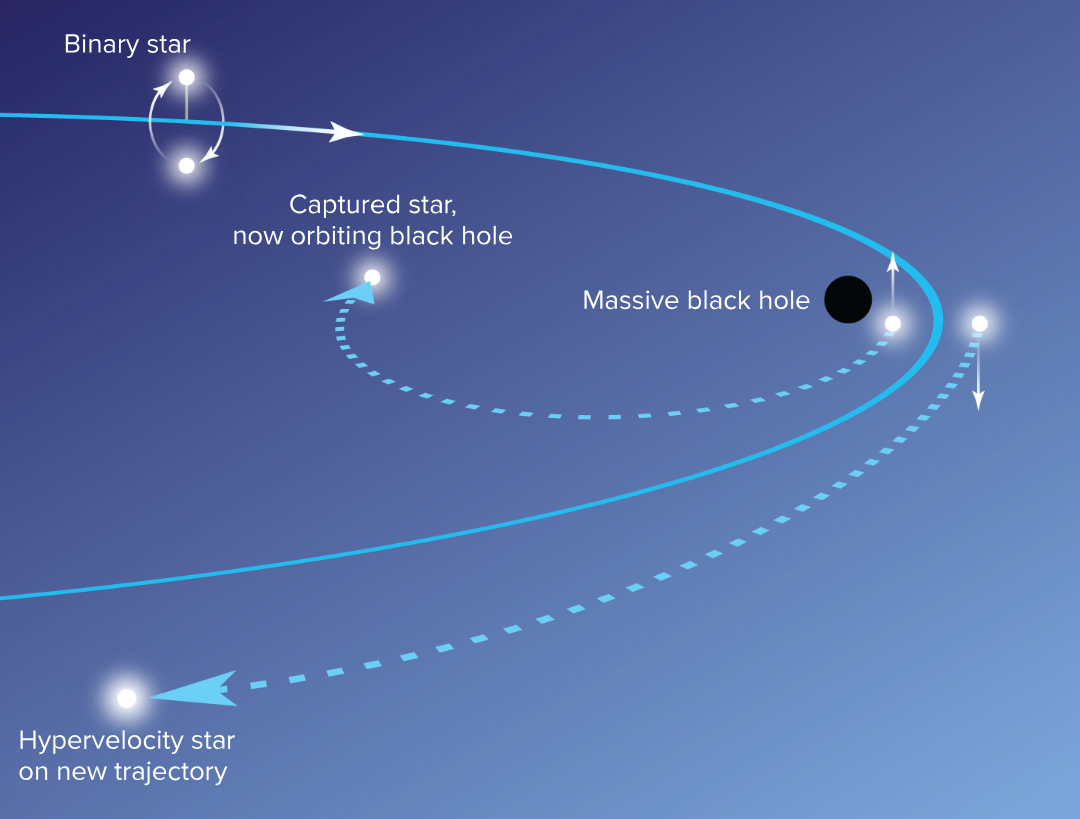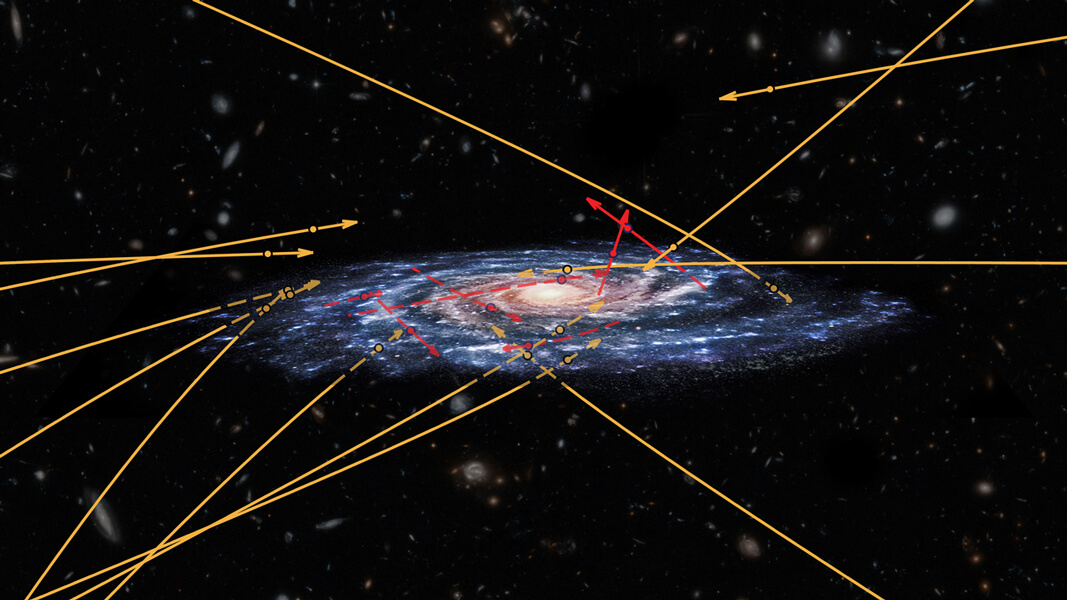Unbound and Out: Boosted by Black Holes, Stars Speed Off, Leaving Clues Behind
Posted on Categories Discover Magazine

Astronomers say the galactic center is home to a black hole (illustration shown) with as much mass as 4 million suns. Its entourage likely includes clusters of stars — many of them orbiting each other in two- or three-star systems — as well as smaller black holes. (Credit: NASA/Dana Berry/SkyWorks Digital)
In April, the European Space Agency released the second massive trove of data from Gaia, a spinning, scanning satellite that for nearly five years has been spying on a billion stars. Its goal is to produce a three-dimensional stellar map, enabling a new age of precision astronomy. Like other stargazers, Warren Brown of the Harvard-Smithsonian Center for Astrophysics has plunged headfirst into Gaia’s data. He’s hoping to find space oddities.
He has found some notable ones before. In 2005, Brown identified a young star speeding at 850 kilometers per second through the Milky Way’s lonely hinterland, called the halo. The star is traveling so fast that it’s unbound, which means that eventually, it will escape the galaxy. Brown coined the term “hypervelocity star” to refer to this breed of superfast stellar travelers.
Brown suspects that the star was flung by the enormous black hole that lies at the center of the Milky Way. The black hole, about 4 million times the mass of the sun, is so powerful that astronomers classify it as supermassive. Black holes are usually thought of as pulling things toward themselves, but they can also act like cosmic slingshots, Brown says. And their ammo can be as big as stars. Once shot, tossed stars may get a one-way ticket out of the galaxy’s grasp.
Since that initial discovery, surveys by Brown and by other astronomers have identified more than 20 unbound, hypervelocity stars of various origins zipping around, including one traveling away from our galaxy that was probably ejected from the Large Magellanic Cloud, a dwarf galaxy companion of the Milky Way. Discussing these discoveries and their implications in the 2015 Annual Review of Astronomy and Astrophysics, Brown explains that, beyond their own interesting origin tales, such exotic stars may also be useful as tools.
Knowable Magazine spoke with Brown about what it takes to escape the galaxy, what Gaia tells us about space oddities and how stellar travelers can help reveal clues about one of the most fundamental mysteries in astronomy — the invisible dark matter that holds the Milky Way together but remains impossible to detect directly. This conversation has been edited for clarity and length.
Where do hypervelocity stars come from?
The fastest ones we’ve found all seem to point back to the galactic center. The measurements aren’t definitive, but with Gaia’s data, I found that the fastest stars are best explained by galactic center ejection. However, I also found that half [of known high-speed stars] did not come from the galactic center. I think that’s cool. There’s a mix of things going on in the Milky Way.
How do you think a star would get ejected from the center of the galaxy?
You have to have at least three things, and one of them has to be a supermassive black hole. If you have a supermassive black hole, then you have a lot of energy, and there are a lot of stars around it that interact.
Then if you have a binary — two stars orbiting each other — approaching a black hole, the gravitational tidal field is so extreme it can pull the pair of stars apart. The capture or ejection depends on the direction of each star’s motion relative to the black hole. Physicists call this a three-body exchange: One star exchanges partners — it gets captured and loses energy. The other escapes, and gains all that energy and just shoots out. That’s the slingshot.
It’s a conservation of energy problem.

In 1988, theorist Jack G. Hills at Los Alamos National Laboratory predicted that stars could be ejected from the Milky Way after an interaction with the black hole at the galactic center. Here’s how it works: A binary star system — two stars spinning around each other – approach a black hole. The closer star gets captured, and its energy is transferred to its former companion, which travels outward so fast that it can escape the gravitational pull of the galaxy. (Credit: Adapted from W.R. Brown/AR Astronomy & Astrophysics 2015/Knowable Magazine)
How do you find a hypervelocity star?
The single answer is speed. They’re not orbiting with everything else in the Milky Way. They’re unbound, and they’re never coming back. That’s what makes them different. There are 100 billion stars that look like every other star, that you don’t care about. It’s very much a needle in a haystack.
When we designed our [2008] survey, which I think is fair to say is the only successful survey of unbound stars in the galaxy, we were looking for young stars — blue stars, hot stars — at very large distances from the center, where they shouldn’t exist, unless they were ejected. And that approach worked, because there are very few young stars out in the outer parts of the Milky Way.
Are you using Gaia to study the hypervelocity stars you already knew about, or are you looking for new discoveries?
Both. A paper we just had accepted was on the 20-some odd, unbound stars found previous to Gaia. We’re also looking at outliers in the Gaia catalog that might be hypervelocity stars. It’s one of these things where we find candidates, but we need follow-up observations to decide.
How does Gaia look at stars?
It’s hard to identify a star other than by its motion. Gaia is trying to measure the tangential motion of the star on the plane of the sky. That’s hard. It’s the product of distance times the angular change over time. In astronomy, you don’t observe distance, you can infer it. And it’s a very small angular change — the angular motion is milliarcseconds in one year, or something. It’s a very tiny angle on the sky that’s changing.
You’ve used Gaia’s data to study halo stars and runaway stars, too. Why are these other space oddities interesting?
Runaway stars were discovered [more than] 50 years ago. They’re interesting because they’re very young, massive stars like the hypervelocity stars we’ve found, but they’re ejected from the disk of the Milky Way — instead of from the center — through binary ejections. Its companion explodes. Well, its former companion explodes, releasing energy. If the star’s direction lines up with the rotation of the galaxy, it suddenly has a speed that can exceed the escape velocity. Those are rare — the ones with those speeds — but they can mimic hypervelocity stars. That’s pretty cool.
Halo stars are normal stars orbiting in the outer parts of the Milky Way. There aren’t a lot of stars way out there. The halo is believed to contain about 1 percent of the Milky Way’s stars, or about 1 billion stars. Halo stars were discovered by Oort and others from the unusual motions of a few stars near the Sun. They orbit in their own way and can appear to have a very different velocity with respect to us. When you’re looking for velocity outsiders, things like halo stars show up. The GAIA Data Release 2 catalog is estimated to have 70 million to 80 million halo stars in its catalog.
Why do you want better measures on unbound stars?
Good measures on the trajectory of hypervelocity stars tell you about how these things were ejected. Was it a single black hole or a binary black hole? It’s fun to think about. The really interesting work is not just in studying the stars themselves but learning what you can do with them and how to use them as tools.
How can a star be useful?
Hypervelocity stars are the ultimate test particle for the gravitational potential of the Milky Way, which is the pull of all the Milky Way’s matter: its stars, gas and dark matter [the invisible matter thought to hold galaxies together]. The gravitational pull varies with position [in the galaxy] because all the matter is distributed across hundreds of thousands of light years of space.
How can hypervelocity stars map the gravitational potential?
If we’re right about where the stars come from, then their arc out of the galaxy tells you the potential of the Milky Way.
We look at the stars at different moments in time. We look at where the star is today, the specific direction its path is following. We can ask: How much does that differ from a straight line to the center? If you know exactly where the star comes from, then any deviation in the measurement of its position tells you how everything else is affecting its path.

stares at billions of stars. In September, after searching Gaia’s data for hypervelocity stars — like the ones predicted by Jack Hills and first discovered by Warren Brown — astronomers not only found stars headed out of the galaxy (shown in red) but also, to their surprise, fast stars traveling toward the galactic center (yellow). These inbound travelers may have been ejected from other galaxies, and are now passing through the Milky Way. (Credit: ESA; Marchetti et al. 2018; NASA/ESA/Hubble)
Imagine the simple case that the galaxy was a perfectly spherical ball. These hypervelocity stars launch in the center and follow a straight line out, but they get pulled down by the pull of the galaxy. The stars in the galactic disk will pull on the star and decelerate it.
How is dark matter distributed in the galaxy?
No one knows, but theoretical simulations predict that the dark matter is not spherical, but distributed with a different length in every direction, like an American football. It’s mostly in the exterior of the galaxy, farther out from the sun.
No one can see the distribution of dark matter directly, but it seems different than that of ordinary matter. Hypervelocity stars can test this, if you can measure their trajectories well enough. These stars are going off in different directions, and in principle each star is a completely independent tracer.
Gaia is still in the midst of its mission. What do you want to see in five years, after the final data release, and in future missions?
Its measurements get better with time, and every star gets measured 70, 80, 100 times. What we have currently is a lot of very good evidence that, taken together, says you have to have stars ejected by a black hole to explain the observations. Presumably, at the end, we’ll have three times better measurements, which means we’ll have three times smaller error bars. Some of the candidates will probably go away, but the end-of-mission Gaia measurements should definitively tell us that these hypervelocity stars are ejected by our galactic center black hole. If they do come from the galactic center, then they can tell us what stars in that region are like. Ironically, hypervelocity stars are easier for us to see than stars that are still in the center of the galaxy, because there’s so much dust and stars in between.
Gaia is not the final piece of evidence, though. We’ll still need spectroscopy to determine the nature of each star. Is it a white dwarf? A main sequence star? An old evolved star?
How else can Gaia’s data help you study hypervelocity stars?
Presumably, we’ll also see stars that we didn’t know about.
This article originally appeared in Knowable Magazine, an independent journalistic endeavor from Annual Reviews. Sign up for the newsletter.